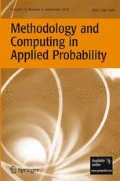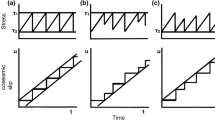Abstract
The present paper aims at the introduction of the semi-Markov model in continuous time as a candidate model for the description of seismicity patterns in time domain in the Northern Aegean Sea (Greece). Estimators of the semi-Markov kernels, Markov renewal functions and transition functions are calculated through a nonparametric method. Moreover, the hitting times for spatial occurrence of the strongest earthquakes as well as the confidence intervals of certain important indicators are estimated. Firstly, the classification of model states is based on earthquakes magnitude. The instantaneous earthquake occurrence rate between the states of the model as well as the total earthquake occurrence rate are calculated. In order to increase the consistency between the model and the process of earthquake generation, seismotectonic features have been incorporated as an important component in the model. Therefore, a new classification of states is proposed which combines both magnitude and fault orientation states. This model which takes into account seismotectonic features contributes significantly to the seismic hazard assessment in the region under study. The model is applied to earthquake catalogues for the Northern Aegean Sea, an area that accommodates high seismicity, being a key structure from the seismotectonic point of view.
Similar content being viewed by others
References
Akritas MG, Roussas GG (1979) Asymptotic expansion of the log-likelihood function based on stopping times defined on a Markov process. Ann Inst Stat Math 31:21–38
Altinok Y, Kolcak D (1999) An application of the semi-Markov model for earthquake occurrences in North Anatolia, Turkey. J Balkan Geophys Soc 2:90–99
Alvarez EE (2005) Estimation in stationary Markov renewal processes, with application to earthquake forecasting in Turkey. Methodol Comput Appl Probab 7:119–130
Cluff LS, Patwardhan AS, Coppersmith KJ (1980) Estimating the probability of occurrences of surface faulting earthquakes on the Wasatch fault zone, Utah. Bull Seismol Soc Am 70: 1463–1478
Deng J, Sykes LR (1997) Evolution of the stress field in southern California and triggering of moderate-size earthquakes: a 200–year perspective. J Geophys Res 102:9859–9886
Garavaglia E, Pavani R (2009) About earthquake forecasting by Markov renewal processes. Methodol Comput Appl Probab. doi:10.1007/s11009-009-9137-3
Gill RD (1980) Nonparametric estimation based on censored observations of Markov renewal process. Z Wahrscheinlichkeitstheor Verw Geb 53:97–116
Lagakos SW, Sommer CJ, Zelen M (1978) Semi-Markov models for partially censored data. Biometrika 65:311–317
Limnios N (1997) Dependability analysis of semi-Markov systems. Reliab Eng Syst Saf 55:203–207
Limnios N, Oprişan G (2001) Semi-Markov processes and reliability. Birkhauser, Boston
Limnios N, Ouhbi B, Sadek A (2005) Empirical estimator of stationary distribution for semi-Markov processes. Commun Stat Theory Methods 34:287–995
Moore EH, Pyke R (1968) Estimation of the transition distributions of a Markov renewal process. Ann Inst Stat Math 20:411–424
Ouhbi B, Limnios N (1999) Non-parametric estimation for semi-Markov processes based on its hazard rate functions. Stat Inference Stoch Process 2:151–173
Ouhbi B, Limnios N (2002) The rate of occurrence of failures for semi-Markov processes and estimation. Stat Probab Lett 59:245–255
Papadimitriou EE, Sykes LR (2001) Evolution of the stress field in the northern Aegean Sea (Greece). Geophys J Int 146:747–759
Papazachos BC, Papadimitriou EE, Kiratzi AA, Papazachos CB, Louvari EK (1998) Fault plane solutions in the Aegean Sea and the surrounding area and their tectonic implications. Boll Geofis Teor Appl 39:199–218
Reasenberg P (1985) Second-order moment of central California seismicity, 1969–1982. J Geophys Res 90:5479–5495
Rhoades DA, Papadimitriou EE, Karakostas VG, Console R, Murru M (2010) correlation of static stress changes and earthquake occurrence in the north Aegean region. Pure Appl Geophys. doi:10.1007/s00024-010-0092-2
Stein RS (1999) The role of stress transfer in earthquake occurrence. Nature 402:605–609
Author information
Authors and Affiliations
Corresponding author
Rights and permissions
About this article
Cite this article
Votsi, I., Limnios, N., Tsaklidis, G. et al. Estimation of the Expected Number of Earthquake Occurrences Based on Semi-Markov Models. Methodol Comput Appl Probab 14, 685–703 (2012). https://doi.org/10.1007/s11009-011-9257-4
Received:
Revised:
Accepted:
Published:
Issue Date:
DOI: https://doi.org/10.1007/s11009-011-9257-4
Keywords
- Semi-Markov process
- Semi-Markov kernels
- Earthquake occurrence rates
- Expected number of earthquake occurrences
- Hitting times




